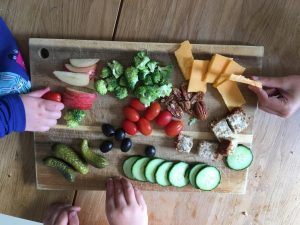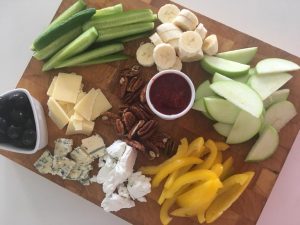Fussy Eater PART III
10 more tips to help you with that find the foodie hidden inside your fussy eater!
1. How to get your fussy eater or any child to eat salad!
The best way to achieve this is tell them you are making a “picnic board” or “snack board”, chop up everything you have in the fridge, including some new, some unusual bits. For example, cherry tomatoes, cucumber sticks, red peppers, apple sliced, nuts, olives, gherkins, dried apricots, some cheese, prunes, chick peas, some leftover pasta, some brown bread chopped into bite-size. Fussy eater
Now the great thing about this is they are;
1) Sharing
2) Exploring
3) Tasting
4) Watching each other
5) Enjoying the experience
6) Getting to try new foods if only to spit it out again
7) Eating what they want
Furthermore,
8) The fussy one (often the youngest) will try stuff they see the older ones trying
8) The board is usually finished and I don’t know who ate what nor do I care.
9) I’m not watching them therefore there is no pressure
10) It is also easier for me to feed kids this way. There are no rules. If I have ran out of bread or don’t want to put on the oven I simply pull out everything in the fridge, chop it up and call it lunch!
2. How much food should you offer kids ??
Offer children small portions to start on a small plate appropriate for their age, why?

- Large portions can be off putting for kids
- You won’t get into a fight about finishing the plate which turns meal times into a negative rather than a positive occasion
- It is better to offer seconds – they are regulating their own appetite and this gives you the opportunity to praise them if they want more
- Parents give their kids too much food often, kids need less food than adults. As a result, their perception of how much they should eat is distorted, your perception of how much they should eat is distorted, this can lead to childhood obesity.
- If they won’t eat their dinner, don’t give up and just start giving them nuggets, sausages or fish fingers. Persevere – they won’t go hungry – don’t give them a taste for processed food – I’d rather they have wholemeal toast with cheese or peanut butter before bedtime with a glass milk. Keep their taste buds intact otherwise, they will develop a preference for processed food and then they won’t go back to eating potatoes, fish & veg. Why would they?
- Cut food into bite sizes – appropriate for their age – it is safer and more appealing and they can use their fingers if they prefer to do so.
3. Get them involved in cooking
- Believe me I have found this frustrating myself at times and through gritted teeth I have watched a 2-year-old make a big mess but this is really important. It is no coincidence that certain countries are known for their food culture (France) and that they include their children in the preparation, cooking and eating of food. They don’t serve their kids a different meal, or at least traditionally they didn’t.
4. Dinner Time
- The same rules apply here whether you have a fussy eater or not!
- Sit together at the table or at least all together at the counter, no television on, no radio on, chat about the food, about their day, eating should be an enjoyable occasion – think of the Italians all sitting around a big table outside, eating fresh seasonal food not take-away pizza around the tv! Which family do you want to be?
- Tell them that they are not allowed up until everyone is finished, this is important because the little one is usually still eating when the eldest is finished and if the eldest gets up – the little one jumps up too.
- Tell them if they don’t try everything on their plate and eat a sufficient amount of food – there is no dessert. Also, they have to stay sitting with everyone else to get dessert.
5. Desserts & treats!
- Mid-week have a healthy dessert – Fruit or yogurt or both, mix it up buy pineapple, mango, raspberries, strawberries, tinned pear in juice. It could be a fresh fruit salad or just one fruit with Greek yogurt.
- A treat isn’t a treat if it is in the house all the time – biscuits – it is just normal food! Only buy treats at the weekend. Do not keep treats in the house – this will save you a daily argument. If they know it’s not there – they don’t ask. If there are dental issues – buy popcorn / crisps / sesame sticks as their treat instead of something sugary.
- Give them dark choc from an early age / before you give them milk chocolate ideally. My kids eat it, I can only assume it’s because it was the only choc in the house from an early age. NOW believe you me!!! They will devour any chocolate BUT they have acquired a taste for dark choc which can only be a good thing
- It’s ok to say ‘No’! Just tell them there is too much sugar in it or it isn’t very healthy. Saying “no” to a child without giving them a reason is harder for them to understand.
6. Baking & Playing house
- Do healthy baking with them. If you are making muffins you don’t have to add sugar, switch it for maple syrup/honey and use ¼ to ½ the amount of sugar recommended. For example, if I am making muffins and the recipe says 200g sugar – I use 2 dessertspoons of maple syrup instead – they will acquire a taste from an early age for “not very sweet treats”.
- If playing house/restaurant with your child and they are the waiter – order healthy food – brown bread cheese & tomato sandwich or a salad not a burger & chips!
7. Buying treats – the supermarket nightmare!
- Try not to buy kids treats while they are with you in a shop – if you do, they will associate shops/supermarkets with getting a treat forever more and they will torment you every time. So, if you don’t already have kids or if you have a baby – this is one you can implement! I go straight to the fruit aisle and if they are looking for something, I buy them fruit, the only other thing I might get is mini cheeses. I have never created the habit so it isn’t an issue.
- Now what if I do want to buy them a treat, for example, an ice-cream during the summer? I pull into a petrol station and give them a few choices and I go into shop alone to get it. If I bring them in and let them pick it out themselves, I know they will look for it every day of the summer and run straight to the freezer, this way they don’t even know where the ice-cream freezer is, you should be the one in control of their treats, not them.
8. Lunchboxes
- Getting kids to eat sandwiches can sometimes be a struggle, especially when they start pre-school – if this is an issue for you – just deconstruct the sandwich. For example, put cherry tomatoes and slices of cucumber into a lunch box and then put brown bread lightly buttered into another with some slices of cheese also in the lunchbox, in other words – let them eat the sandwich as finger food.
- When you pick them up from creche/school – check their lunchboxes when you get into the car, if they didn’t eat their lunch in school, they will be hungry at this stage. Often the reason for not eating their lunch can be lack of time in school or wanting to play instead, don’t always assume they didn’t like it. I get them to eat their lunch on the way home or while we wait for their sibling to come out of school. This also takes the pressure off feeding them immediately when you get in the door.
9. Convenience baby foods
- I get asked a lot about packaged baby foods – so some are not bad nutritionally, but let’s be honest they don’t taste like real food, my rule is if I wouldn’t eat it myself why should they have to eat it. You are teaching them that Spaghetti Bolognese tastes like Brand X Spaghetti Bolognese then they may actually reject yours, this may even create a fussy eater!. It can create problems with food preferences and tastes and textures down the line if over used!! They are meant for convenience and are fine to use when travelling, keep one in the changing bag in case you are stuck. Great for planes and bringing abroad as you won’t have a food processor etc.
10. Don’t ever utter the words “you probably won’t like that”
- Don’t ever utter the words “you probably won’t like that”, without realising parents put their preferences onto kids. If you are a fussy eater, they will be. If you ARE fussy perhaps hide it! One of my kids went to eat a whole clove of garlic one day and my husband tried to jump in to stop them, and I was thinking “sure worst-case scenario they will spit it out, who cares, they will get an injection of antioxidants if they do eat it, and guess what they liked it”.
Talk very positively about food – tell them they are a little “foodie
- Talk very positively about food, about your relationship with food, tell them you love trying new foods. If at a farmer’s market or food festival let them see you trying new foods – e.g. An oyster for the first time, tell them you are really happy with yourself for trying something new. Tell them they are a little “foodie” – associate being a foodie with being a good thing, something to be proud of, something special. Tell them you are a foodie, that you love food and love healthy food and love trying new foods.
- Now I have to admit my eldest is an exceptional eater. BUT all 3 of my children went through a fussy stage, this is not unique, 2-4 yrs is the fussy stage. Stick with it, don’t give into the processed food, trust that they will come good. They learn from you and they learn from each other. Don’t panic, some people are a self confessed fussy eater until they are 25 but they get there. Give them a chance! Accept that they are toddlers, they don’t need to be labelled a fussy eater.

